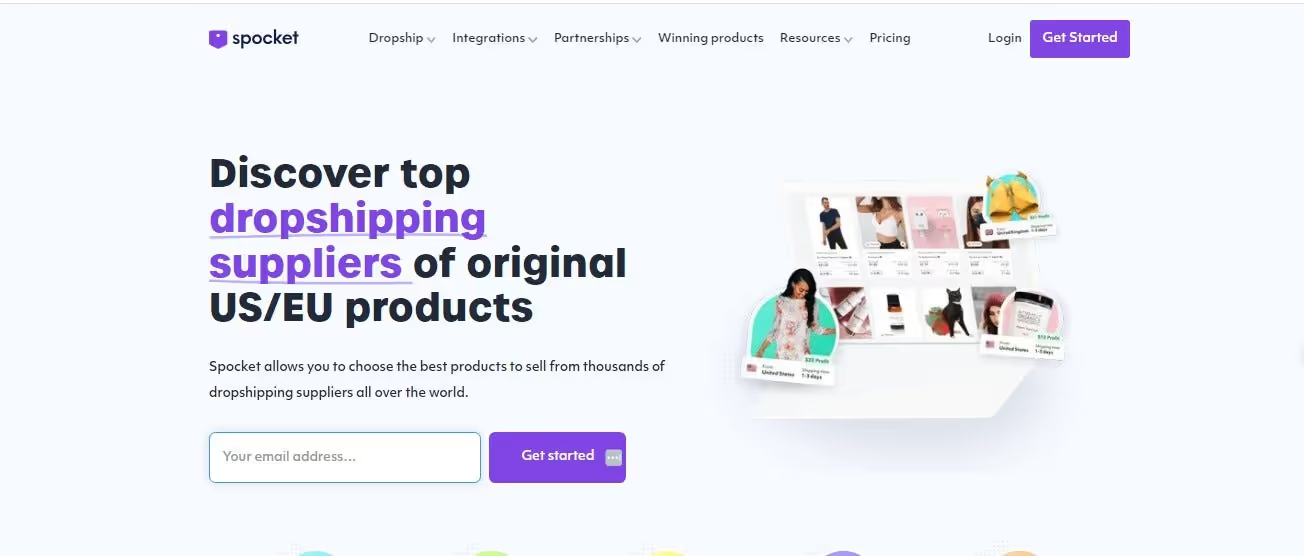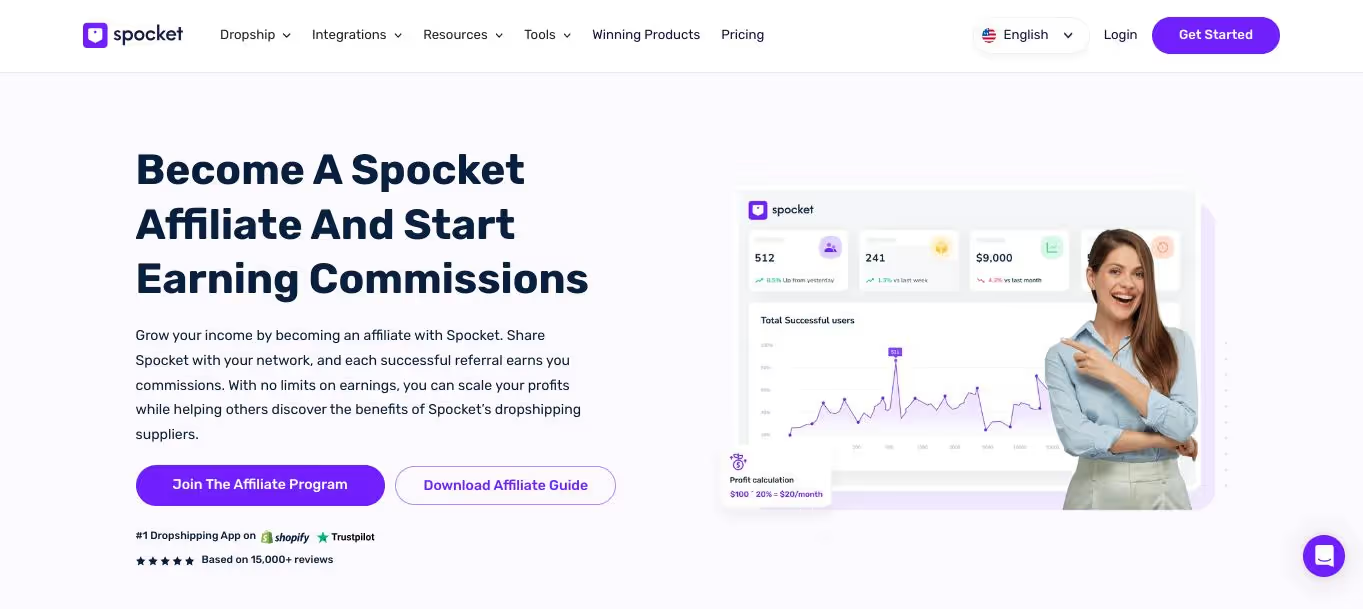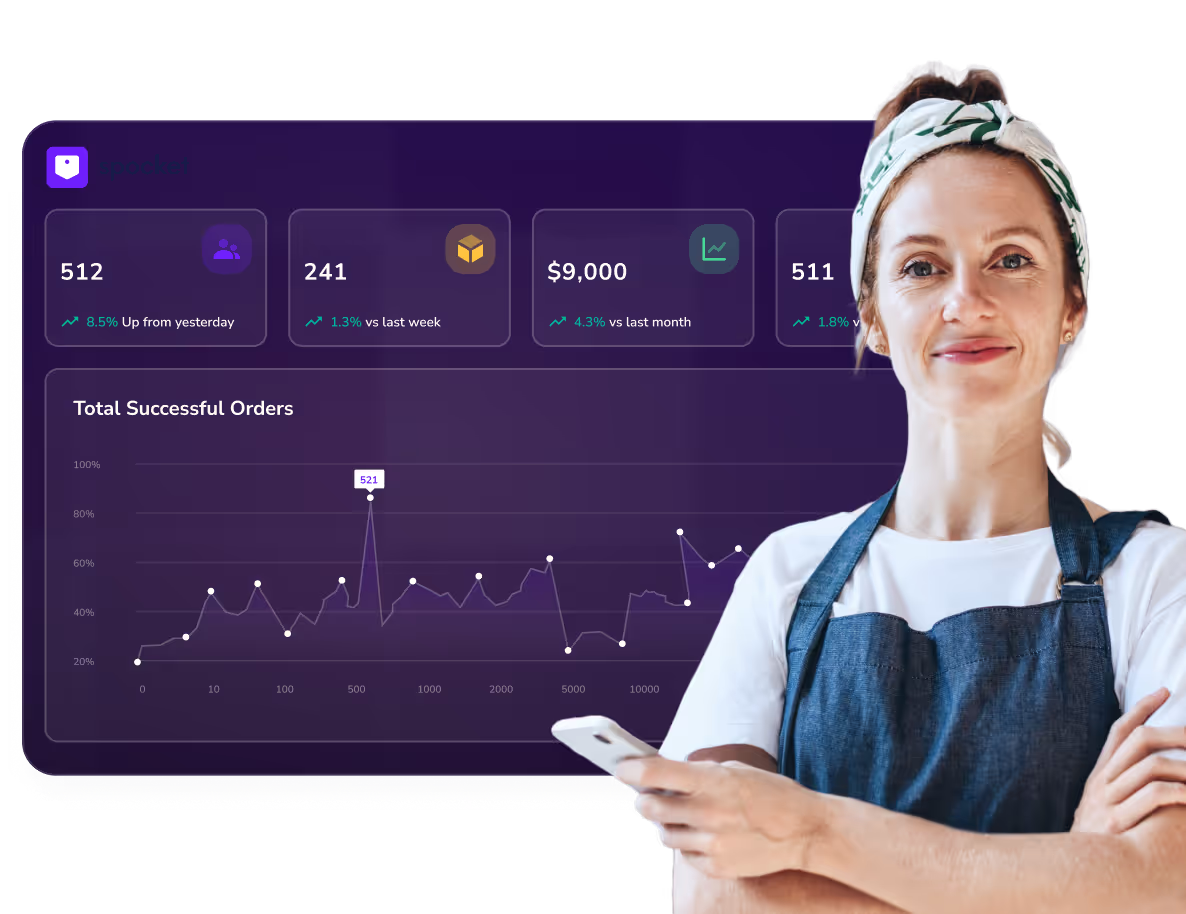Blogging isn’t just a hobby anymore—it’s a legit way to make real money online. But if you’re wondering, how can we earn money from blog posts without feeling overwhelmed or stuck, you’re in the right place. The truth is, making money from blogging isn’t about luck or writing viral posts. It’s about using smart strategies, understanding your audience, and choosing the right ways to monetize your content.
Whether you want to earn a side income or build a full-time online business, there are multiple paths to explore. From affiliate marketing and sponsored posts to selling digital products—and yes, even dropshipping with platforms like Spocket—there’s something that can fit your style and niche.
In this guide, we’ll walk you through practical, real-world methods to turn your blog into a money-making machine. No fluff, just clear, actionable steps you can start using today.
Understanding Blog Monetization: What Does It Really Mean?
Before diving into how to earn money from your blog, it’s important to understand what blog monetization actually is. Monetization is simply turning your blog’s visitors and content into income, but it’s not just about slapping ads everywhere. It’s about building trust and offering value that people want to pay for—whether directly or indirectly.
Monetizing your blog is like running a business. The more you know your audience and deliver what they need, the better your chances to make consistent income. Let’s break down what that means and why audience matters more than just chasing dollars.
What Is Blog Monetization?
At its core, blog monetization means making money from the traffic and influence your blog generates. This can come from ads, selling products, services, or even partnering with brands. But here’s the catch: without readers who actually care about your content, none of these methods will work well.
Think of monetization as the bridge between your passion and profit. You’re not just writing for yourself—you’re creating something valuable enough that people want to support or buy from you. That’s why growing an engaged audience is step one.
Why Building an Audience Matters More Than Quick Money
It’s tempting to want instant cash from your blog. But the reality is that people don’t hand over money just because you have a website. They invest when they trust you and see your blog as a helpful resource.
Focusing on building genuine relationships and delivering consistent value creates a loyal following. Over time, that audience becomes your best asset for turning blog visits into dollars. Monetization is the result of a strong connection, not a shortcut.
How Can We Earn Money From Blog? Exploring Proven Methods
There’s no one-size-fits-all answer to monetizing your blog. The best approach is to mix and match several income streams that fit your niche and audience. Below, you’ll find some of the most effective and realistic ways bloggers earn money today.
Each method has its own perks and challenges, so it’s worth understanding how they work and which ones suit you best.
1. Dropshipping Through Your Blog with Spocket

A smart way to boost your blog income is by adding dropshipping. Dropshipping lets you sell physical products without stocking inventory.
With Spocket, you connect to reliable US and EU suppliers who handle shipping for you. Imagine a lifestyle blogger selling curated home decor items featured in blog posts.
You drive your blog traffic to your dropshipping store, earning profit on every sale without the usual hassles of inventory.
Dropshipping with Spocket fits perfectly with blogs looking to diversify income and offers real product value to readers.
2. Affiliate Marketing – Promote Products and Earn Commissions

Affiliate marketing is a classic and beginner-friendly way to earn money. Simply put, you recommend products or services, and when your readers buy through your special links, you get a commission.
The key is to promote things your audience actually needs or wants. For example, a tech blog might recommend gadgets, while a health blog might promote supplements.
Pick affiliate programs like Amazon Associates or niche-specific platforms. Write honest reviews, how-to guides, or comparison posts, and naturally include your affiliate links.
If your blog focuses on e-commerce or dropshipping, the Spocket Affiliate Program is a great choice. Spocket connects entrepreneurs with trusted suppliers from the US and Europe, making it easier to find quality products to promote.
By joining their affiliate program, you can earn up to 30% commission for every customer you refer who starts dropshipping with Spocket. The program offers a 90-day cookie window, giving you a longer chance to earn from your referrals.
Integrate Spocket affiliate links in blog posts about dropshipping tips, product reviews, or online business guides. Just make sure your recommendations feel genuine, and your readers will trust you more.
3. Display Advertising – Using Platforms Like Google AdSense
Display ads are those banner or text ads you often see on websites. Google AdSense is the most common platform that helps bloggers place these ads.
You earn money based on clicks or impressions—meaning the more visitors you have, the better your chances to earn. But remember, too many ads can annoy readers, so balance is important.
Start with ads once your blog gets steady traffic and test placements to maximize income without harming user experience.
4. Sponsored Content and Brand Collaborations
Brands want to reach your audience and may pay you to create sponsored posts or reviews about their products.
To attract sponsors, build your blog’s reputation and grow your traffic. Be transparent about sponsored content to keep your readers’ trust.
Sponsored posts can pay well and open doors to long-term brand partnerships.
5. Selling Digital Products and Online Courses
If you have skills or knowledge, why not package it as a digital product? This could be an eBook, printable planner, or an online course.
Digital products often bring high profit margins because you create them once and sell repeatedly.
Use your blog to educate your readers and offer your products as solutions to their problems.
6. Offering Freelance Services or Consulting
Your blog shows off your expertise. Use it as a platform to attract freelance clients or consulting gigs.
Writers, designers, coaches, and marketers often get clients through blog content that showcases their skills.
Create a clear “Services” page and share client testimonials to build credibility.
7. Memberships, Subscriptions, and Patreon
If you have a loyal following, memberships or subscriptions offer steady income.
Exclusive content, webinars, or early access to posts can motivate readers to pay monthly.
Platforms like Patreon simplify managing members and help you reward your community.
Picking the Right Blog Niche for Monetization Success
Choosing the right niche can make or break your chances of earning money from blogging. Not all topics attract paying audiences or profitable products to promote.
In this section, we’ll explore how to find a blog niche that matches your passion and has real earning potential. This way, you’re not just writing for fun—you’re building a blog that can grow into a sustainable income source.
Why Niche Choice Matters
A focused niche helps you attract a specific audience that trusts your expertise. When readers see you as an authority in one area, they’re more likely to follow your recommendations and buy what you suggest.
Also, some niches have better monetization options than others. For example, finance, health, tech, and lifestyle blogs often have plenty of affiliate programs, advertisers, and product opportunities.
How to Pick a Profitable Niche
Start by listing topics you enjoy and know well. Then, research if people are searching for those topics online and if there are products or services related to them.
Tools like Google Trends, keyword research tools, and competitor analysis can help. Look for niches where demand is steady or growing but competition isn’t overwhelming.
Examples of Niches With High Monetization Potential
- Personal finance and investing
- Health and wellness
- Tech gadgets and software
- Home decor and lifestyle
- Parenting and family tips
Finding the right niche sets the foundation for all your monetization efforts. A smart niche means your blog will attract the right audience and open doors to multiple income streams.
Growing Your Blog Audience: Traffic is the Foundation of Income
No matter which monetization method you choose, the key to earning money from your blog is attracting visitors. Without traffic, there’s no one to see your ads, click your affiliate links, or buy your products.
In this section, we’ll cover practical ways to grow your audience so you can turn those visitors into steady income.
SEO Basics for Bloggers
Search Engine Optimization (SEO) helps your blog rank higher on Google, bringing in free, organic traffic. Start with keyword research to find the exact phrases your audience types when searching.
Use those keywords naturally in your blog titles, headings, and content. Focus on answering questions thoroughly and providing value that beats what’s already out there.
Leveraging Social Media for Blog Growth
Social media platforms like Instagram, Pinterest, TikTok, and Facebook are excellent channels to share your blog content and connect with your target audience.
Create engaging posts related to your blog topics. Repurpose blog content into images, videos, or stories to reach more people. Interact with your followers to build a community that’s eager to visit your blog.
Building an Email List to Boost Monetization
An email list gives you direct access to your readers, unlike social media where algorithms control who sees your posts. Offer freebies like guides or checklists to encourage visitors to subscribe.
Send regular newsletters with helpful content, updates, and promotions. Emails often convert better than other channels because they reach people who already trust you.
Creating Content That Converts: Writing for Income
Your blog content is more than just words on a page—it’s the heart of your business. To earn money, you need posts that not only attract readers but also inspire action.
In this section, we’ll explore how to write blog posts that engage your audience and drive income.
Focus on Value and Clarity
Your readers come to your blog looking for answers, inspiration, or entertainment. Make sure your posts clearly solve their problems or meet their needs. Use simple language and avoid jargon unless it’s necessary—and always explain it.
Break down complex ideas into easy steps. Use bullet points, numbered lists, and short paragraphs to keep things digestible.
Tell Stories and Share Personal Experience
People connect with stories more than dry facts. Share your own experiences, successes, and even failures. This builds trust and makes your blog more relatable.
For example, if you’re recommending a product or a strategy, explain how it worked for you or someone you know.
Include Clear Calls-to-Action (CTAs)
Every post should guide readers on what to do next—whether that’s clicking an affiliate link, signing up for your email list, or checking out your dropshipping store.
Use friendly CTAs like “Check this out,” “Download your free guide,” or “See how you can get started.” Make sure the CTA feels natural and fits the context of your post.
Managing Expectations: How Long Does It Take to Earn Money From Blogging?
Starting a blog is exciting, but it’s important to be realistic about how quickly you’ll make money. Blogging is rarely an overnight success.
This section will help you understand the typical timeline for earning and why patience and consistency are your best friends.
The Early Months: Building Foundations
Most blogs don’t earn much in the first few months. This time is for creating quality content, growing your audience, and experimenting with monetization methods.
Think of it as planting seeds. You’re laying the groundwork that will pay off later.
When Money Starts Coming In
Many bloggers see their first real income between 6 to 12 months. This varies depending on your niche, effort, and marketing skills.
Don’t get discouraged if it takes longer. Keep learning, improving, and engaging your readers.
Persistence Pays Off
Blogging income tends to grow over time. As you add more content and build trust, your audience—and your earnings—will increase.
The key is to stay consistent, adapt to feedback, and keep refining your strategy.
Tools and Resources Every Blogger Needs to Monetize Successfully
Using the right tools can save you time, improve your blog’s performance, and boost your earnings. While you don’t need everything at once, having a solid toolkit makes a big difference.
Let’s look at some essentials that support your monetization journey.
1. Reliable Hosting and Blogging Platforms
Choose a hosting service that offers fast loading speeds and good uptime. WordPress.org is a popular platform because of its flexibility and plugins that help with SEO and design.
A slow or unreliable website can drive visitors away, so invest in quality hosting from the start.
2. SEO and Keyword Research Tools
Tools like Ahrefs, SEMrush, or budget-friendly options like Ubersuggest help you find the right keywords and track your rankings.
Good SEO tools guide your content creation and show you where to improve so more people find your blog.
3. Email Marketing Software
Building an email list is crucial, and platforms like Mailchimp, ConvertKit, or Sendinblue make managing subscribers and sending newsletters easy.
Email marketing helps turn casual readers into loyal followers and customers. Choosing the right email marketing platform ensures your campaigns are automated, personalized, and backed by analytics for better results.
4. Affiliate Networks and Dropshipping Platforms
Join affiliate networks such as Amazon Associates or niche-specific programs to find products to promote.
If you’re into dropshipping, platforms like Spocket connect you with reliable US and EU suppliers, letting you sell products directly through your blog without managing inventory.
5. Course and Membership Platforms
If you plan to sell digital products or run memberships, platforms like Teachable, Kajabi, or Patreon make it simple to deliver content and handle payments.
Avoiding Common Blogging Monetization Mistakes
Making money from your blog is a learning process, and it’s easy to slip into habits that hurt your growth or income. Knowing common pitfalls helps you stay on the right path.
Here are some mistakes to watch out for:
1. Overloading Your Blog with Ads and Affiliate Links
It might be tempting to plaster your blog with ads or push affiliate links aggressively, but this can annoy your readers and drive them away.
Keep your monetization subtle and relevant. Prioritize quality content and user experience over quick bucks.
2. Ignoring Your Audience’s Trust
Trust is everything in blogging. If readers feel you’re only after money, they won’t come back.
Be honest and transparent about sponsored content and affiliate links. Recommend only products and services you believe in.
3. Focusing Only on Traffic, Not Engagement
High traffic doesn’t always mean high income. If visitors don’t engage with your content, sign up for your list, or take action, monetization will suffer.
Build relationships by responding to comments, emails, and creating interactive content.
4. Not Diversifying Income Streams
Relying on a single income source is risky. If one stream dries up, your earnings vanish.
Mix affiliate marketing, ads, product sales, and dropshipping (like with Spocket) to create stable, multiple revenue channels.
Conclusion
Making money from your blog takes time, effort, and a smart mix of strategies. Whether it’s affiliate marketing, display ads, selling digital products, or even dropshipping with platforms like Spocket, the key is to find what fits your niche and audience best.
Dropshipping through Spocket is especially powerful because it lets you offer quality products without holding inventory or dealing with shipping logistics. This can add a whole new income stream to your blog, helping you diversify and grow your earnings.
Remember, blogging is a marathon, not a sprint. Focus on building trust, creating valuable content, and growing your audience steadily. With persistence and the right tools, your blog can become a reliable source of income that grows with you over time.
So start experimenting, stay consistent, and don’t hesitate to explore new ways to monetize—your blogging success story is waiting to be written.






































